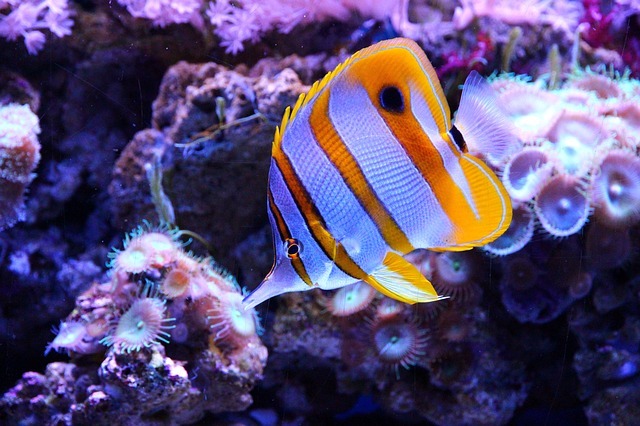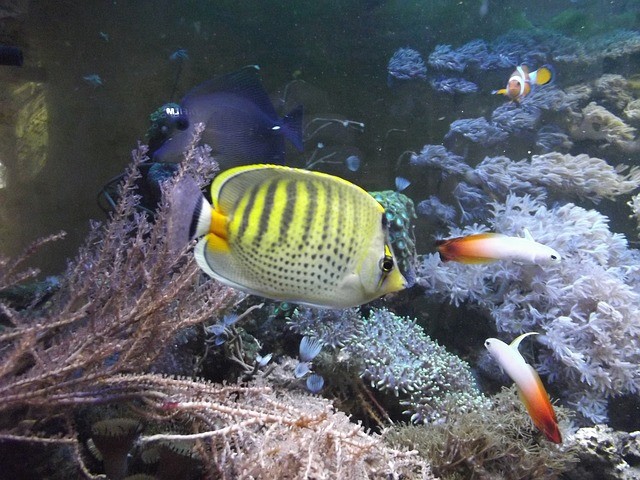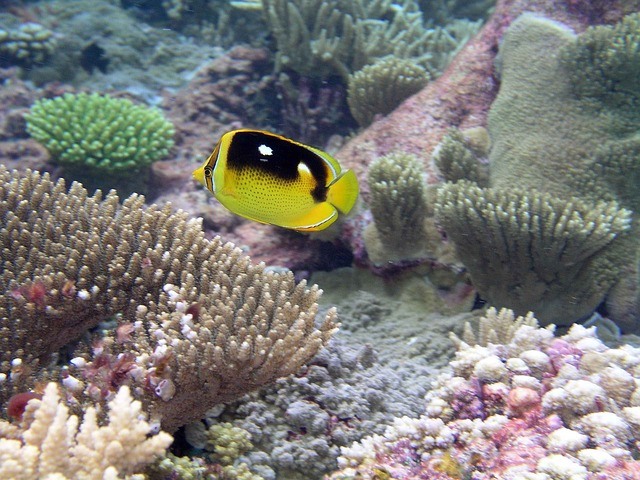Butterfly fish are a beautiful, elegant family of tropical fish that make quite the pretty picture. Their vivid colors as well as graceful swimming attracts aquarists and divers alike, and make little kids visiting the aquarium go ‘Ooh!’ while squishing their face against the glass.
Given this, it isn’t all that surprising to know that saltwater butterfly fish are incredibly popular with aquarists. Their stunning coloration and docile temperament make these fish a wonderful addition to any tank.
Just because they are easy on the eye does not mean they are an easy fish to care for, however. Depending on the specific breed of butterfly fish, they can be notoriously difficult to take proper care of. Some breeds cannot live in tanks at all!
But that’s not to say a novices saltwater aquarist couldn’t nurture a butterfly fish to a full life. It will just take a lot of dedication and research to ensure they’re living in an appropriate tank with tankmates they get along with.
So, if you want to learn all you can about butterfly fish care, you have come to the right place!
Contents
How to Set Up Your Butterfly Fish Aquarium
Tank Requirements
The first factor any aquarist will consider, when it comes to introducing new fish to the tank, is if their current tank, or the one they are upgrading to, is big enough for their new fishy friend.
All fish, not just butterfly fish, will do better and be happier in a tank of the appropriate size. Butterfly fish in particular, though, need a tank that allows them plenty of room.
A large tank is important, too, if the aquarium will be medium to high in population.
At the minimum, all breeds of butterfly fish must be in a 125-gallon tank. A 200- to 300-gallon tank is good for most aquarium-compatible butterfly fish – and you will need that space too, as you will see in the sub-section below!
On average, butterfly fish will grow between six inches and eleven inches. The largest butterfly fish that can live in an aquarium is the Saddle Butterfly fish, which can hit a whopping foot and a half in length!
Do your research on the specific breed of butterfly fish you are getting, to be sure that the tank will fit them once they reach their full size.
Water Requirements
As butterfly fish are from tropical reefs, they need water that sits somewhere between 72 degrees F and 78 degrees F. Be sure to get heaters that can sustain a constant temperature in large tanks.
Fish that have to rapidly adjust from warm to cold temperatures can fall into poor health from over-stressing their systems.
As for pH levels, an ideal place to sit is between 8.1 and 8.4. Investing in a pH testing kit, or stocking up on a few cheap ones, is a good idea.
Good quality aquarium stores will often perform a free pH test on any water samples you bring to them!
Tank Set-Up
Butterfly fish are not necessarily shy, but they are reef fish and thus need hiding spaces to chill out in.
Live rocks and corals are ideal for butterfly fish, and reef fish in general, as they provide a natural replica of their habitat in the wild.
Plain rocks and artificial decorations are still perfectly acceptable. However, it is important to arrange them in a way that provides a number of crevices and caves large enough for the fish to hide in.
Now, don’t go packing the tank full of decorations and plants. Butterfly fish still need plenty of space to swim around in. If you have territorial fish in your tank, these open spaces and caves are even more important!
Aquarium Lighting
Tropical reef fish benefit most from having lights and a light cycle that replicates nature, and this includes butterfly fish. This means turning the lights off at night, tempting as it might be to have it lit during the dark hours.
Depending on the depth of your tank and its inhabitants, the specific wattage and strength of the bulbs you need to get will vary.
Reef lighting is beautiful, designed to imitate sunlight refracting through gentle waves, and can be well worth investing in.
Another item to factor in is if you have live coral in the tank. Live corals need specific lighting conditions in order to thrive, and considering how much they cost, you really want them to keep growing!
Butterfly Fish Food
So, what do butterfly fish eat?
Well, there is a good reason why most butterfly fish need to live in fish-only tanks. These fellas love nibbling on small crustaceans and will gobble up any shrimp you put into the tank – whether they are meant to be eaten or not!
Butterfly fish need varied diets too. They cannot live on one kind of food and must have a balanced diet of frozen foods, live brine, algae, spirulina, flakes, live shrimp, and plankton.
Some even eat coral. If they do, you can only have certain types of coral in your tank. The specific foods you need will depend on the specific kind of butterfly fish you own.
Some are omnivorous, others are not. Be sure to do a little research on the exact dietary needs of the butterfly fish you are caring for!
Butterfly Fish Tankmates
Aside from the more aggressive butterfly fish, like the Falcula or Saddleback, these fish are peaceful and will happily coexist with many other species.
Close quarters can create stressful situations if there isn’t space or a hole to retreat to, so keep this in mind if your tank is starting to look a little crowded.
Several kinds of butterfly fish naturally form schools with their own kind! Others can be more solitary, and can get quite territorial.
As for other fish species that get along with the butterfly fish – clownfish, damsels, gobies, parrotfish, tang, and hogfish are equally docile cohabitants.
Community tanks are great for butterfly fish! Just make sure they have a space to call their own in the tank. Beware! Mated pairs can become very territorial, even outside of breeding season.
Butterfly Fish Care
Care Difficulty
Remember the whole ‘butterfly fish aren’t great for novices’ spiel at the start of this guide? Let’s come back to that topic.
Certain breeds of butterfly fish are easier to care for than others. This does not mean that the easier ones are actually easy to take care of. Truthfully, butterfly fish are not recommended for those new to saltwater aquariums.
If you are not a novice or are a very determined one willing to put in the effort, read on to see which breeds of butterfly fish are suitable for your skill level.
Moderately Difficult
These fish can adapt to tank life relatively quickly and will eat most aquarium foods with live food supplements.
The following fish are moderately difficult to care for:
- Indian Butterfly fish.
- Long-Nosed Butterfly fish.
- Klein’s Butterfly fish.
- Vagabond Butterfly fish.
- Threadfin Butterfly fish.
- Teardrop Butterfly fish.
- Raccoon Butterfly fish.
- Black and White Heniochus Butterfly fish.
Difficult
These fish can require a varied diet with live foods, corals, and shrimp. They are not recommended for the inexperienced.
The following fish are difficult to care for:
- White-Faced Butterfly fish,
- Sunset Butterfly fish,
- Peppered Butterfly fish,
- Saddled Butterfly fish,
- Pakistan Butterfly fish,
- Merten’s Butterfly fish,
- Golden Butterfly fish,
- Copperband Butterfly fish,
- Pearlscale Butterfly fish,
- Spot-Banded Butterfly fish, and,
- South African Butterfly fish.
Extremely Difficult
These fish are not viable in home aquariums. Fish experts would struggle to keep one of these fish happy and healthy for an extended period of time.
- Chevron Butterfly fish.
- Rainford’s Butterfly fish.
- Bennett’s Butterfly fish.
Introducing Butterfly Fish to the Tank
Before you go buying a bunch of butterfly fish, there is one more key piece of information you need to know. Despite being a family of fish, the individual breeds all have wildly differing needs when it comes to habitat, diet, and so forth, making it tricky to balance a tank for two or more different kinds of butterfly fish.
Now, introducing a butterfly fish to your tank can be a process. This is because they are rather difficult to breed in captivity, and many you will find in stores are caught in the wild.
In part, this is why butterfly fish are difficult to care for – you have to adapt them to life in an aquarium.
When introducing one to your tank, take the following steps to minimize stress and make the transition as smooth as possible.
- Turn the lights off and darken the room where the tank is located; this will calm any occupants already in the tank.
- If possible, move a few decorations around to disturb any established territories, although this is really only a step you need to take if your fish are territorial or aggressive.
- Feed any existing occupants.
- Place the butterfly fish in a clear container, or in the baggie the fish was transported within, in the tank for 10-20 minutes. This acclimatizes the fish to the tank’s temperature and their new surroundings.
- Add a cup or so of the tank’s water to the container with the butterfly fish. Let it sit for another 5 minutes.
- Slowly tip the container and release the fish.
It is a good idea to keep the lights off or low for a few hours after releasing the fish, and be sure to check for any aggressive behavior over the next few days.
Here’s a video showing some care information on the Copperband butterfly fish.
Conclusion
A healthy butterfly fish can live up to 10 years! Staying informed and reading up on this colorful family of fish is a great way to prepare for owning one.
Just remember, the butterfly fish is a beautiful but tricky fish to care for.






